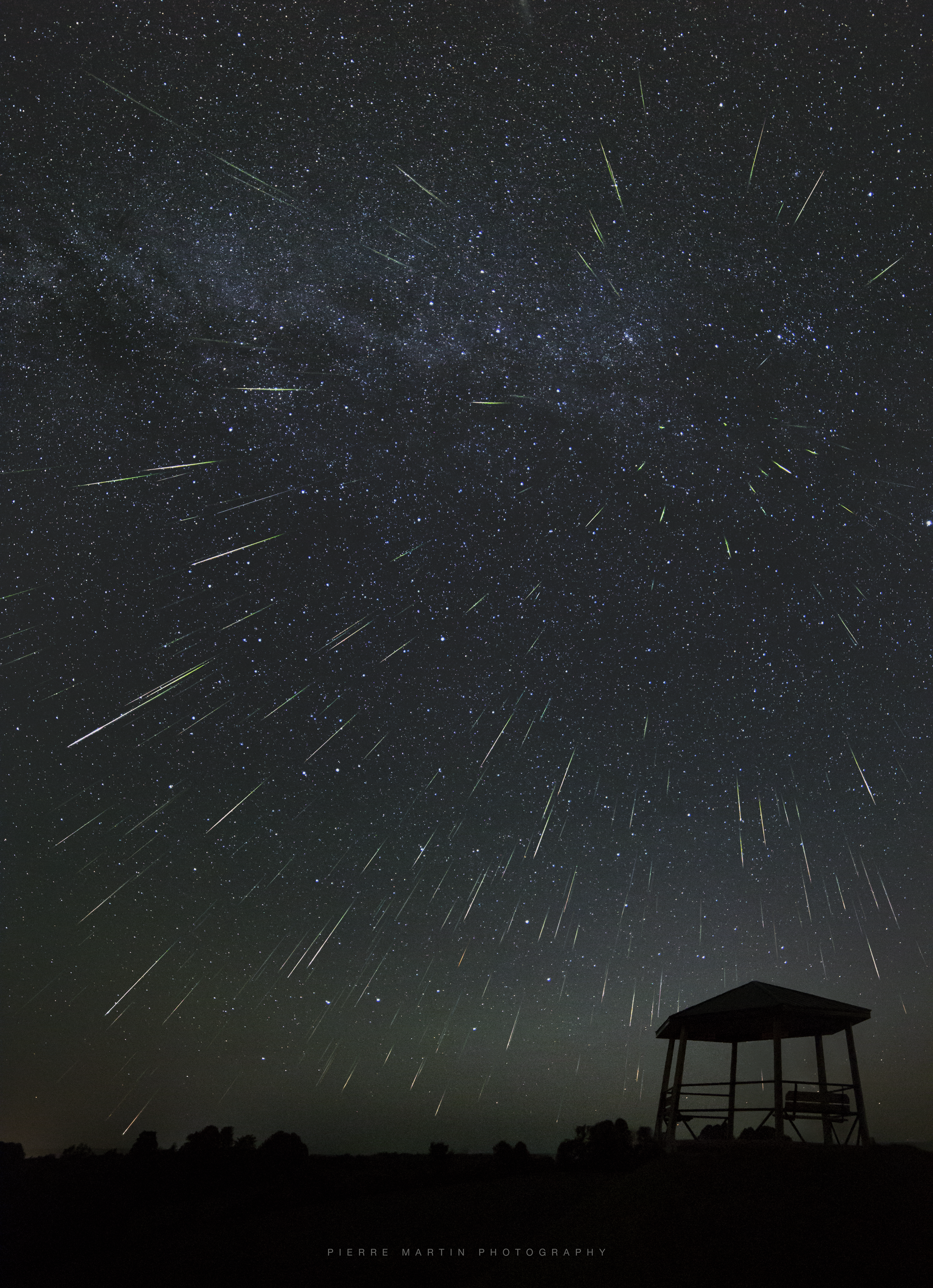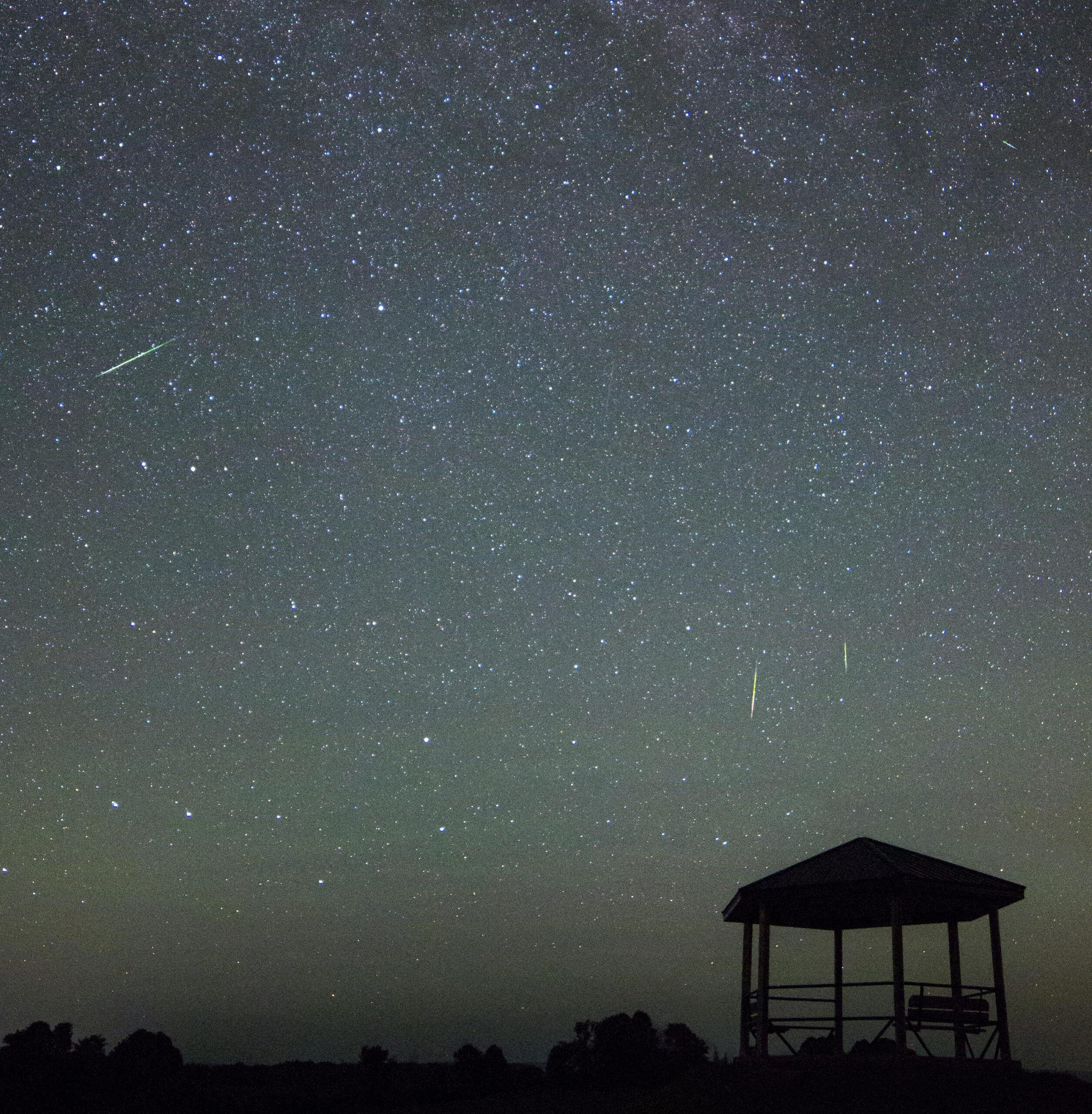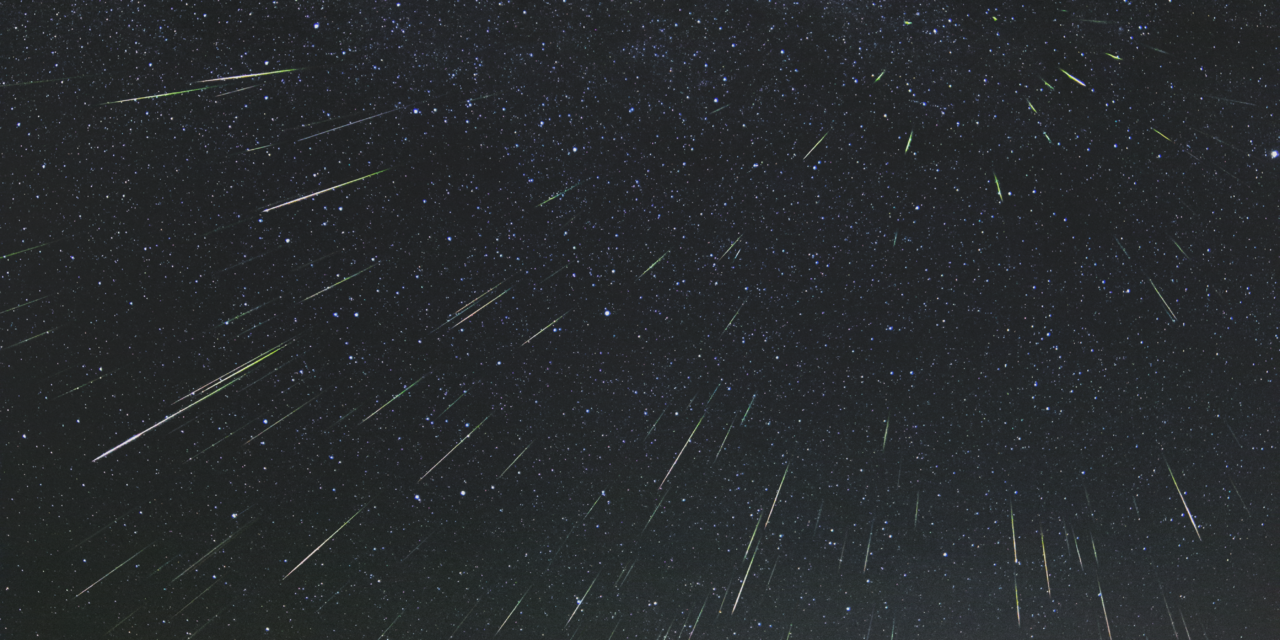Here’s my report on an extraordinary and surprising 2021 Perseid meteor outburst.
This was a session that nearly didn’t happen. On the afternoon of August 13, I looked at what the weather forecasts had in store for the coming night. It was pretty questionable. It was becoming cloudy, and a series of thundershowers were in the forecast for the evening hours. On the other hand, the weather forecasts showed a cold front approaching the region overnight. It appeared that locations roughly 80-100 km northwest of Ottawa would start clearing just after 1am local time. I was exhausted from the previous nights up watching and photographing the Perseids, so I was thinking that I would skip this night to get some much needed sleep. I went to bed early but I woke up just before 11pm. I rechecked the weather just out of curiosity, and I found that the satellite image was matching the model forecasts quite well. The nap made me feel more rested and I decided to go for it! The car was still mostly packed from the previous night so I was able to get ready quickly. I took off to Westmeath Lookout; a two hour drive! This was as far as I was willing to go, as it was already late. I left my east-end Ottawa home at 11:30pm and drove through terrible weather conditions. More than once, I went through a heavy downpour (at times with poor visibility as one wall of heavy rain hit after another). Along the way, I contemplated turning around and returning home as the weather seemed to be getting worse. But I pressed on, and made it to Westmeath Lookout, arriving there at 1:30am EDT. In a sharp contrast, the weather was so much nicer out there! It was dry, the wind was picking up significantly and the sky was clearing just as expected! Yeah!!! The air felt wonderfully dry and a mild 15C, which was great compared to the hot, muggy days we had throughout the summer. As the last few clouds receded to the east, I spent a few minutes just looking up and admiring the sky before setting up. I was awed by the clarity. The Milky Way was thick and showed a wealth of details against a sea of faint stars! A few Perseids and sporadics flashed by! WOW!! What a great view! So, I grabbed my chair, a blanket, my observing accessories bag, a small table, the coffee and snacks, and I made my way up the hill to setup. The camera bag stayed in the car for now.
Westmeath Lookout is a beautiful and tranquil public sight seeing area, located within the Whitewater Region (a township on the Ottawa River in Renfrew County, eastern Ontario). It is popular for taking in panoramic views of the Ottawa Valley scenery from an elevated point, or for seeing sunsets or sunrises. There is a paved parking lot at the base of the hill, and a gazebo at the top. It is a fairly steep climb uphill by foot (better suited for light setups), but well worth it. The site has dark mag 6.7 skies overhead, and 360 degrees views of the horizons!
With the clouds completely gone, the transparency was excellent. It was the best I had seen this year and I was excited! I setup my chair facing east, with the wind on my back. I signed on at 05:50 UT (01:50am EDT local time). Right away, I was seeing very good meteor activity, with Perseids coming in with one or two per minute. Then it was followed by a few minutes of absence. The lulls were however few and far in between before more meteors would appear. I presumed that the excellent sky transparency helped with the visibility of the meteors, but I was suspicious that something unusual might be happening. Then, in just 7 minutes between 06:26 UT (02:26am EDT) to 06:33 UT (02:33am EDT), I saw 18 meteors (with as many as 14 Perseids)! This was a far stronger rate than what I would expect to see a full day after the annual maximum. One of the Perseids was a -3 that flared with an 8 seconds train! I was now convinced that an outburst was in progress! I took a pause from visual observing, quickly went back down the hill to my car to grab my camera bag, and a small tripod, and back uphill I went. Meteors flashed left and right on the periphery of my vision, and a sense of excitement and adrenaline kicked in! I quickly setup my camera (a Canon 6D with a 14mm f/2.8 lens) towards the north where the sky was darkest. I didn’t have my dew heaters and batteries, so instead, I improvised by putting a couple of hand warmers in a sock, and wrapping it around the lens to keep dew from forming on the optics. I set the interval-meter to run continuous 20 seconds exposures for the rest of the night.
I settled back on my chair at 06:55 UT (02:55am EDT) to resume visual observing. The meteor action continued — in fact, it got better and better! After 07 UT (3am EDT), the Perseids were going crazy!!! Multiple meteors per minute was becoming common! Perseids went left and right, up and down all over the sky! Just before 03:30am EDT, I muttered in my tape recorder… “What the heck is going on? Ohhh and there goes another one!!!”. I started counting the seconds in between meteors, and I would typically get to 15 or 30 seconds before I would see another. In some instances, two or three meteors would flash one after another, all within a second! The outburst peaked at about 08:15 UT (04:15am EDT). My highest 10-minute count was 42 Perseids with a radiant elevation of 61 degrees! Then, the outburst started declining just as morning twilight grew stronger past 08:30 UT (4:30am EDT).
The Perseids brightness was on the average/faint side, and no major fireballs occurred. A small proportion of Perseids stood out. At 06:26 UT (02:26am EDT), a -3 Perseid flared and left an 8 seconds train. At 07:27 UT (3:27am EDT), a similar -3 Perseid produced a terminal flash and left a 3 seconds train.
In three hours of observing 05:50 UT (01:50am EDT) to 09:08 UT (05:08am EDT), I saw 394 meteors (340 Perseids, 9 kappa Cygnids, 7 Northern delta Aquariids, 2 anthelions, 2 eta Eridanids, one alpha Capricornid, one August xi Draconid and 32 sporadics). My visual hourly rates for the Perseids were 64, 162 and 114! These rates make the 2021 Perseids the most active Perseid meteor shower that I’ve seen in my 33 years of observing! Sporadics were quite active with hourly rates of 14, 12 and 6. Talk about a stunning night, it was something really special! My only wish is that more people would have seen this display.
I observed as long as I could before the morning twilight was too strong, ending just after 5am local time. I was still full of energy, and I was eager to find out if anyone else had seen the outburst within the meteor community. I sent a message to Koen Miskotte, long time amateur astronomer specialized in meteors from the Dutch Meteor Society, alerting him on what I had just seen and asking if he was aware? Koen responded a short time later that he hadn’t yet seen other reports. He looked at the preliminary worldwide radiodata at and then he wrote back to me with… “WOW radio data got crazy!”. It confirmed a strong, sharp outburst near solar longitude 141.47 above North American longitudes. Koen was interested in calculating a preliminary visual ZHR using my counts, producing a preliminary summary article, and sharing visual data with Peter Jenniskens (SETI Institute and NASA Ames Research Center). So as soon as I arrived home, I got busy listening to my voice recordings, noting all the times and numbers of meteors seen. I then shared my 5-minute interval counts with Koen (included further below). That same day, Koen posted a “first results” summary on the MeteorNews website, and shortly after that, P. Jenniskens also wrote a summary. The ZHR as calculated by Koen was 245 ± 37 and there may have been two peaks. By averaging the values, the ZHR calculates at 210 ± 20. These rates are 4 to 5 times higher that what you would expect at that time. Six observers saw the outburst, but unfortunately, three of them had poor observing conditions, or saw only part of the outburst. I was one of the few meteor observers in North America privileged with excellent sky conditions at the ideal time.
STRONG OUTBURST PERSEIDS ON AUGUST 14, 2021 ~ 06-09 UT!
On the following day, P. Jenniskens, posted this ‘Central Bureau for Astronomical Telegram’ (CBET) to the broader astronomical community.
More recently, a detailed collaborative article was published: THE BIG SURPRISE: A LATE PERSEID OUTBURST
By Koen Miskotte (Dutch Meteor Society), Hirofumi Sugimoto (The Nippon Meteor Society) and Pierre Martin (Ottawa, Canada)
The 364 exposures produced by my camera helped determine the photographic ZHR. I supplied Koen a list with the number of Perseids per image with a time indication. To determine the photographic ZHR, the 20-second counts were summed to 15-minute counts. Determining this requires constant weather conditions and a fixed camera that must be pointed exactly at the same point during the entire period (unguided) and settings may not be adjusted. The purpose of this ZHR determination was not so much to determine the ZHR but more to see where the maximum photographically took place. The photographic maximum occurred at at λʘ = 141.470° very close to the time of the visual and radio maxima.
My images were also the basis of the composite that I created by co-adding all 282 captured into one image. It is not often that I submit my images to APOD (NASA Astronomy Photo of the Day) but a few people suggested that I should submit this one. On September 23, I received an email from Jerry T. Bonnell (UMCP) (one of the two authors and editors for APOD) letting me know that my image would run as APOD for the following day!
It was a night that I won’t soon forget! It was followed by a collaboration between the amateur and professional astronomical community, coordinating in a way to quickly disseminate data results of this unusual outburst. It is not yet clear what mechanism is behind this outburst (as well as the less dramatic ones seen in recent years, shortly after the traditional maximum). Perhaps further research by meteor dynamicists and future observations will provide answers. It goes to show that even the more well known meteor showers such as the Perseids can provide nice surprises. In this case, the effort and sleep deprivation was very much worth it!

Above: Composite image of 282 Perseids captured between 06:50 UT (2:50am EDT) and 09:00 UT (5:00am EDT) on the night of August 13/14 2021. Canon 6D at ISO 6400, 20 sec exposures, Rokinon 14mm f/2.8 lens. Setup was mounted on tripod unguided. 364 continuous exposures were made of which 282 meteors were found, and digitally combined into this image (a few additional Perseids were found but are not included here due to sky rotation). Sporadics and other minor shower meteors are not included. Photographed near Westmeath, Ontario by Pierre Martin. A high resolution version of the composite image on my photo gallery site.

Above: A single 20 seconds exposure with 4 Perseids taken at 07:17 UT (3:17am EDT) on August 13/14 2021. Canon 6D at ISO 6400, Rokinon 14mm f/2.8 lens. Photographed near Westmeath, Ontario by Pierre Martin.
Observation August 13/14 2021, 05:50-09:08 UT (01:50-05:08 EDT local time)
Location: Westmeath Lookout (Beachburg), Ontario, Canada
(45° 47’ 34”, -76° 51’ 32”)
Observer: Pierre Martin
IMO session: https://www.imo.net/members/imo_vmdb/view?session_id=82735
Observed showers:
August xi Draconids (AXD) – 18:24 (276) +55
zeta Draconids (AUD) – 19:06 (287) +59
kappa Cygnids (KCG) – 19:08 (287) +52
alpha Capricornids (CAP) – 21:10 (317) -05
Anthelion (ANT) – 22:20 (335) -10
Northern delta Aquariids (NDA) – 23:14 (349) +02
Southern delta Aquariids (SDA) – 23:24 (351) -14
Perseids (PER) – 03:30 (053) +59
eta Eridanids (ERI) – 03:15 (049) -10
Standard one hour visual periods (times in UT):
05:50-07:08 UT (01:50-03:08 EDT); 5/5 trans; F 1.00; LM 6.65; facing E55 deg; teff 1.00 hr
PER: sixty-four: -3; -2; -1; 0(6); +1(7); +2(15); +3(7); +4(10); +5(15); +6(1)
KCG: four: 0; +3(2); +4
ANT: two: +3; +4
NDA: two: +4; +5
CAP: one: +1
ERI: one: +4
AUD: one: +4
Sporadics: fourteen: +1(2); +2; +3; +4(5); +5(5)
Total meteors: Eighty-nine
07:08-08:08 UT (03:08-04:08 EDT); 5/5 trans; F 1.00; LM 6.65; facing E55 deg; teff 1.00 hr
PER: one-hundred-sixty-two: -3; -1(3); 0(9); +1(19); +2(37); +3(33); +4(32); +5(28)
KCG: two: -1; +6
NDA: two: +3; +4
Sporadics: twelve: +1(2); +2; +3; +4(4); +5(3); +6
Total meteors: One-hundred-seventy-eight
08:08-09:08 UT (04:08-05:08 EDT); 4/5 trans; F 1.00; LM 5.81; facing E65 deg; teff 1.00 hr
PER: one-hundred-forteen: -1(2); 0(4); +1(20); +2(23); +3(23); +4(27); +5(14); +6(1)
KCG: three: +4(2); +5
NDA: three: +1; +3; +5
ERI: one: +1
Sporadics: six: +1; +3(2); +4(2); +5
Total meteors: One-hundred-twenty-seven
Short visual periods (times in UT):
0550-0555 (0.0833 teff, LM=6.65); 6 PER, 1SPO
0555-0600 (0.0833 teff, LM=6.65); 3 PER, 2 KCG, 1 ERI, 1 SPO
0600-0605 (0.0833 teff, LM=6.65); 3 PER, 1 NDA
0605-0610 (0.0833 teff, LM=6.65); 1 ANT, 2 SPO
0610-0615 (0.0833 teff, LM=6.65); 6 PER, 1 KCG, 3 SPO
0615-0620 (0.0833 teff, LM=6.65); 4 PER, 1 KCG, 1 SPO
0620-0625 (0.0833 teff, LM=6.65); 3 PER, 1 ANT, 1 AUD, 1 SPO
0625-0630 (0.0833 teff, LM=6.65); 6 PER, 1 CAP, 2 SPO
0630-0635 (0.0833 teff, LM=6.65); 9 PER, 1 SPO
0635-0637 (0.0333 teff, LM=6.65); 2 PER, 1 NDA
0655-0700 (0.0833 teff, LM=6.65); 12 PER
0700-0705 (0.0833 teff, LM=6.65); 4 PER, 2 SPO
0705-0710 (0.0833 teff, LM=6.65); 11 PER, 1 SPO
0710-0715 (0.0833 teff, LM=6.65); 9 PER
0715-0720 (0.0833 teff, LM=6.65); 13 PER, 1 NDA, 1 KCG, 3 SPO
0720-0725 (0.0833 teff, LM=6.65); 15 PER, 3 SPO
0725-0730 (0.0833 teff, LM=6.65); 15 PER, 1 SPO
0730-0735 (0.0833 teff, LM=6.65); 11 PER
0735-0740 (0.0833 teff, LM=6.65); 9 PER, 1 SPO
0740-0745 (0.0833 teff, LM=6.65); 8 PER, 1 NDA, 1 SPO
0745-0750 (0.0833 teff, LM=6.65); 21 PER, 1 SPO
0750-0755 (0.0833 teff, LM=6.65); 16 PER, 1 KCG
0755-0800 (0.0833 teff, LM=6.65); 13 PER
0800-0805 (0.0833 teff, LM=6.65); 14 PER
0805-0810 (0.0833 teff, LM=6.65); 19 PER, 2 KCG, 2 SPO
0810-0815 (0.0833 teff, LM=6.65); 22 PER, 1 NDA
0815-0820 (0.0833 teff, LM=6.65); 9 PER, 1 KCG
0820-0825 (0.0833 teff, LM=6.55); 17 PER, 1 NDA
0825-0830 (0.0833 teff, LM=6.52); 16 PER, 1 ERI, 3 SPO
0830-0835 (0.0833 teff, LM=6.49); 9 PER, 1 NDA
0835-0840 (0.0833 teff, LM=6.45); 10 PER
0840-0845 (0.0833 teff, LM=6.25); 6 PER
0845-0850 (0.0833 teff, LM=5.90); 6 PER, 1 SPO
0850-0855 (0.0833 teff, LM=5.40); 3 PER
0855-0900 (0.0833 teff, LM=5.20); 6 PER, 1 SPO
0900-0908 (0.1333 teff, LM=3.80); 4 PER, 1 SPO
Break: 0637-0655 (18 minutes)
Total meteors for this session: 394



Great work Pierre! An important discovery for better understanding the perseid.